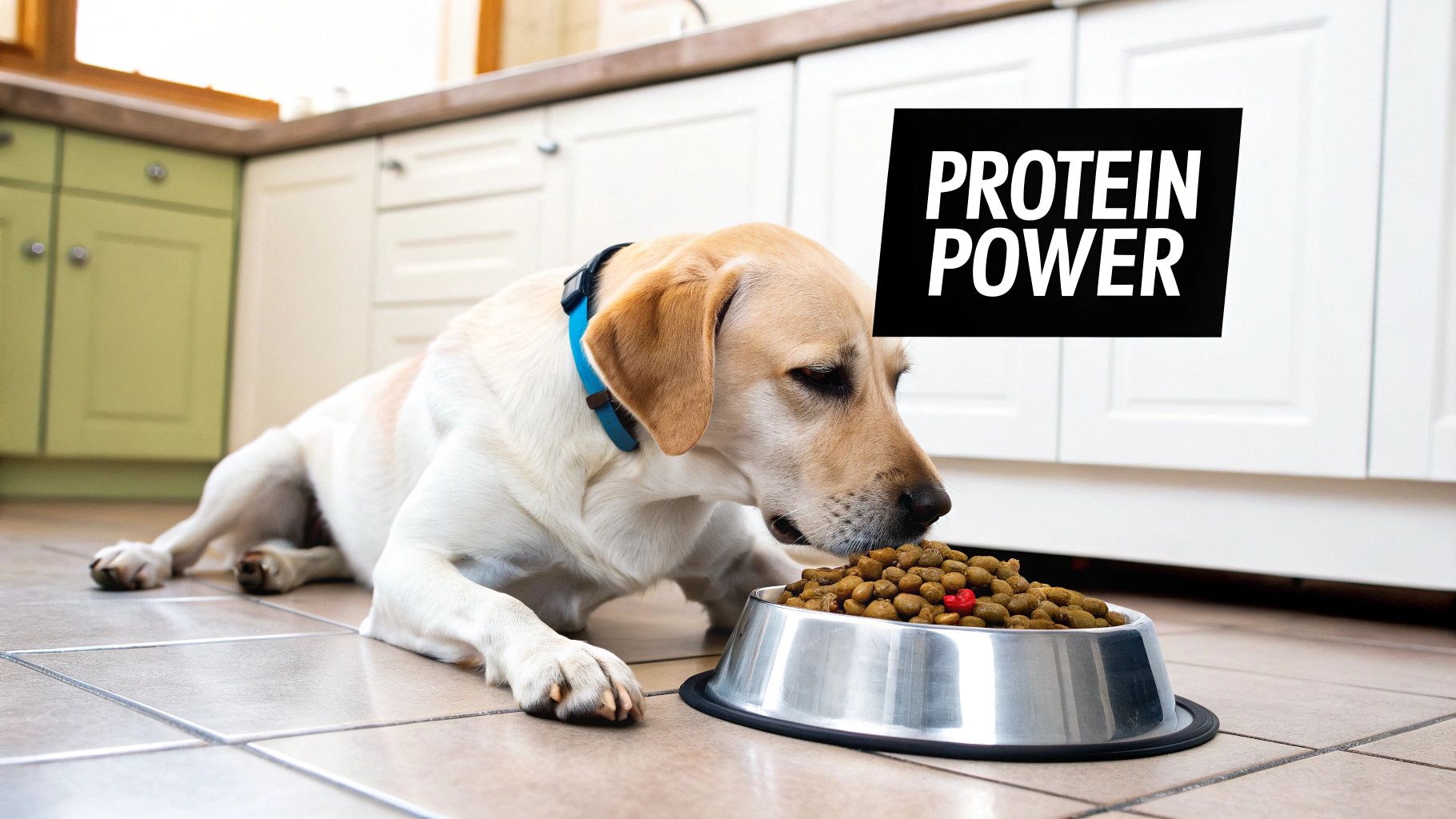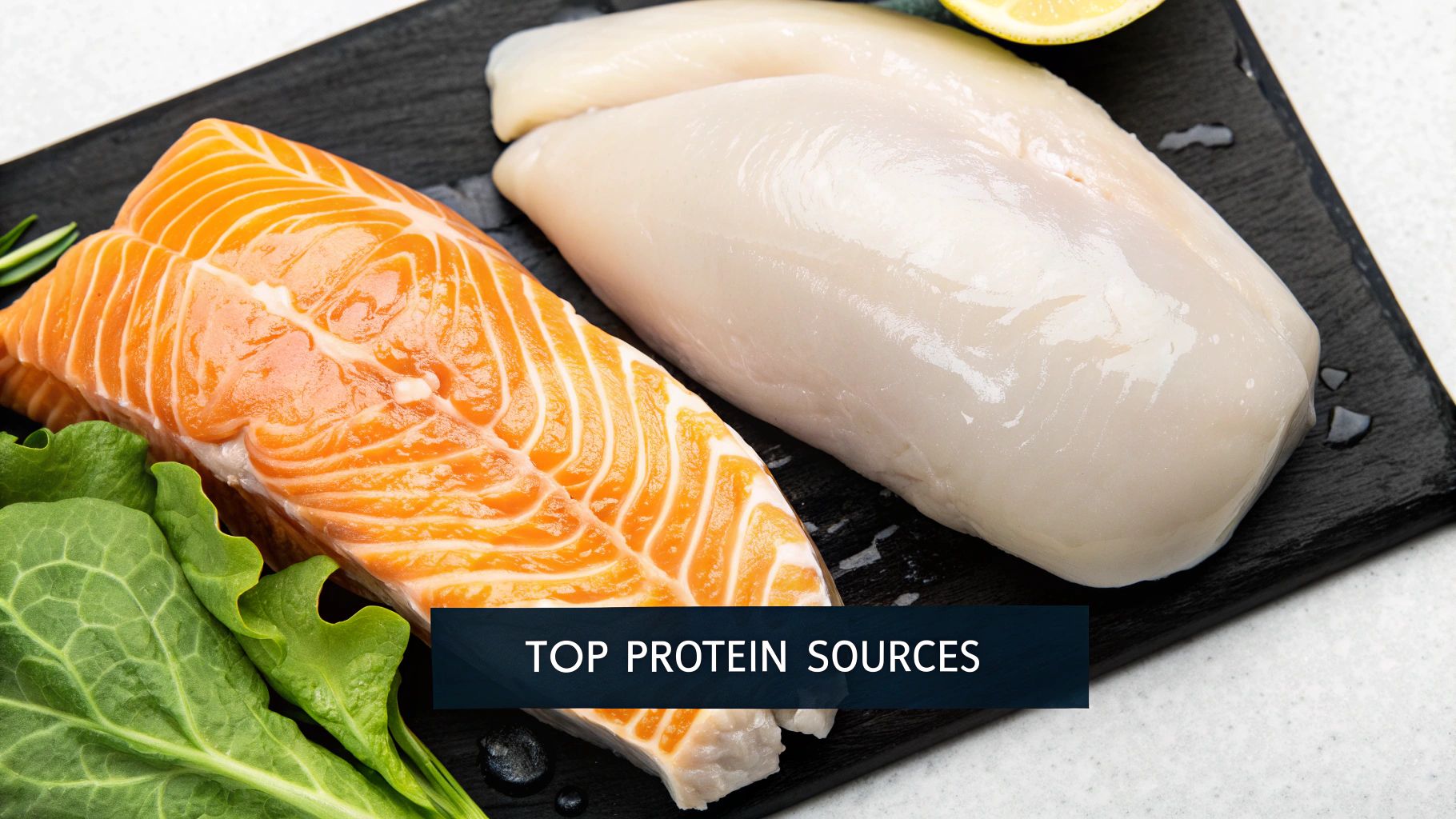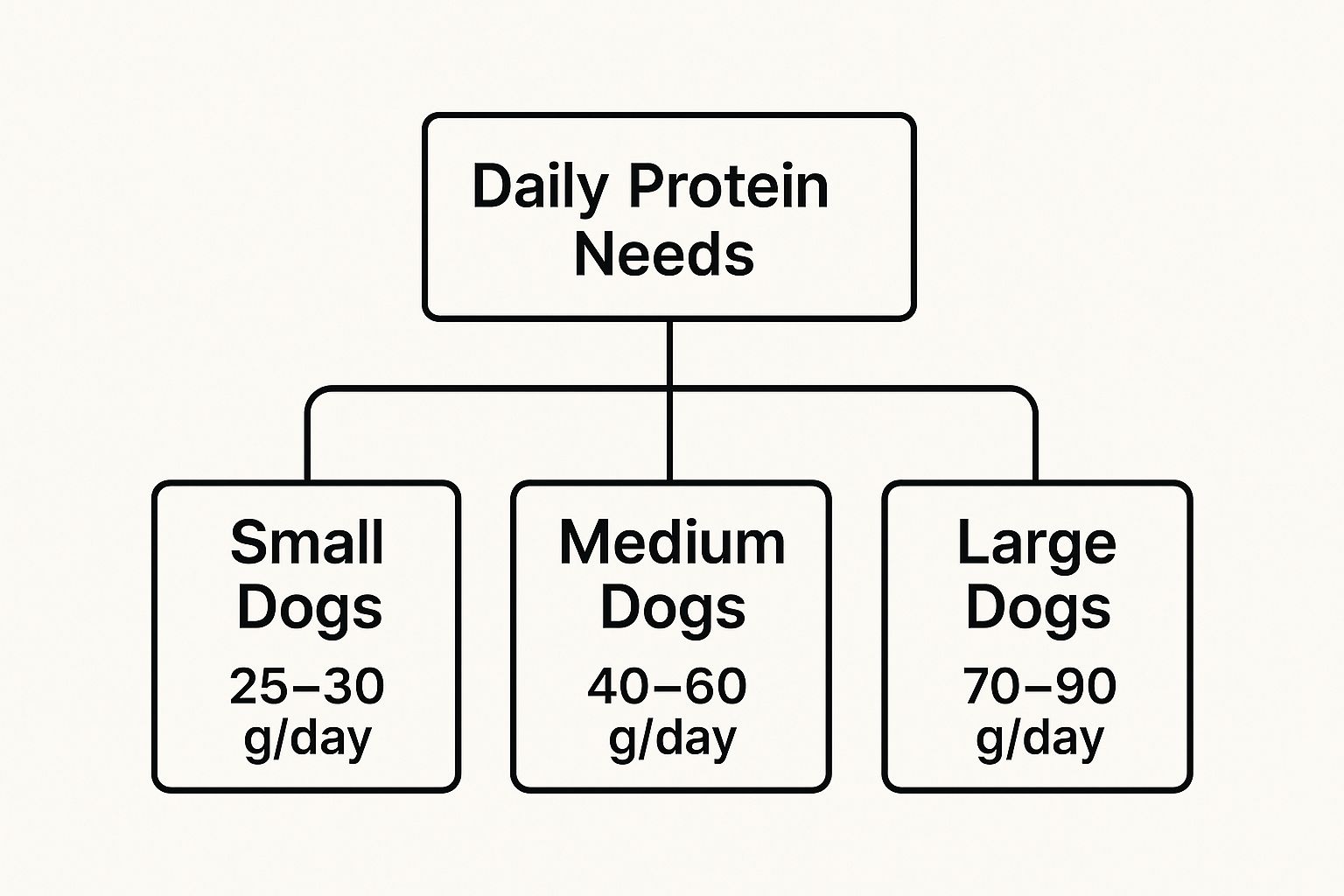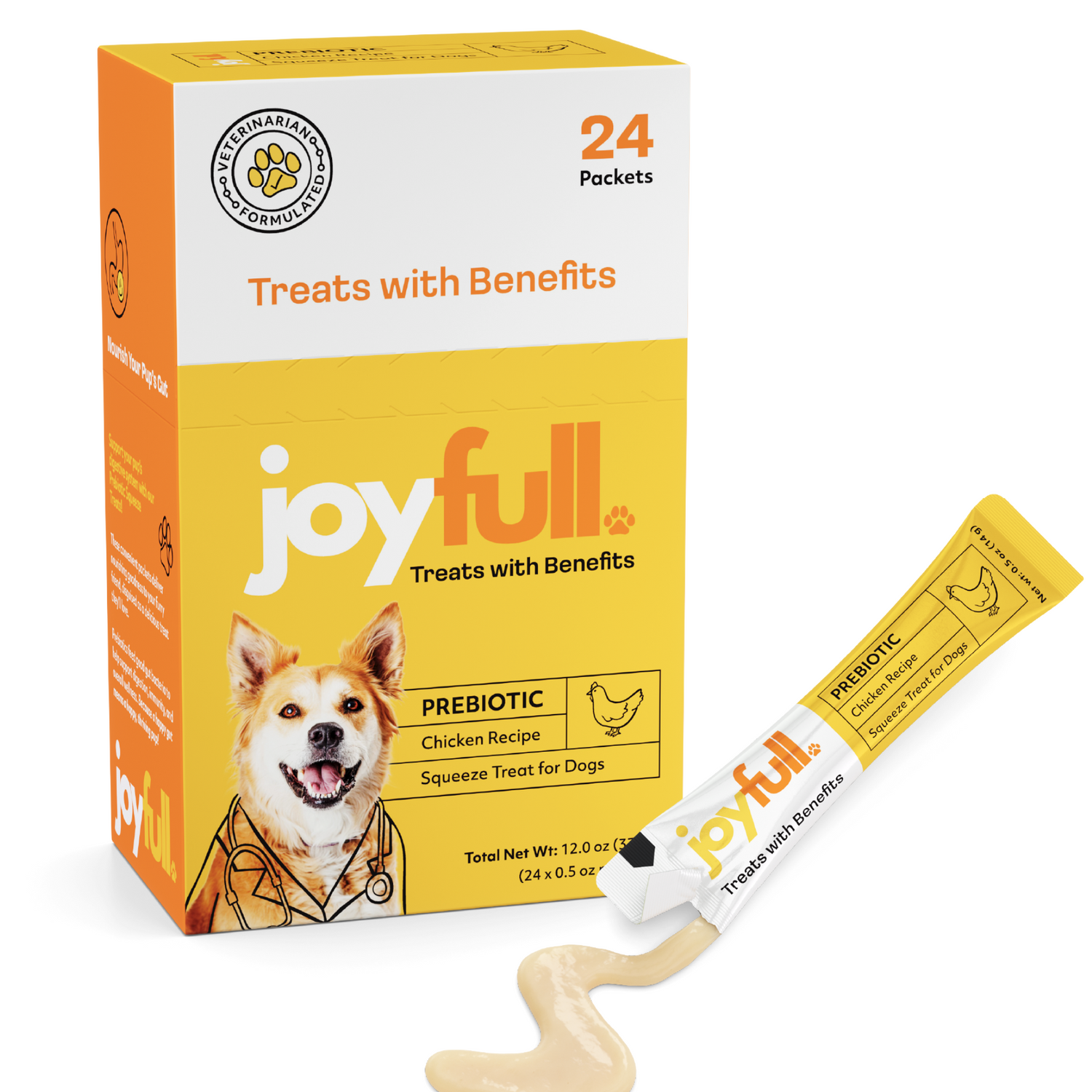
High Quality Protein for Dogs Guide
Here’s a simple truth that every dog owner should know: not all protein is created equal. The very best high-quality protein for dogs comes from animal-based sources that are easy to digest and packed with a full set of essential amino acids. Think of it as the premium fuel your dog needs to build strong muscles, keep their energy levels up, and support their overall health.
What Makes a Protein High Quality for Dogs

Let's try an analogy. If you were building a house, high-quality protein is like using strong, perfectly-formed bricks. These bricks create everything from lean muscle to a resilient immune system. Low-quality protein, on the other hand, is like using crumbly sand—it just can't build a sturdy, stable structure to support your dog's vitality.
To really get what makes a protein source top-notch, we need to talk about two key ideas: its amino acid profile and its bioavailability. These aren't just fancy science terms; they're the secret to unlocking your dog's best health.
The Power of Amino Acids
You’ve probably heard amino acids called the "building blocks of life," and it's a perfect description. When your dog eats protein, their body gets to work breaking it down into these vital components. A dog's body can’t make 10 of these amino acids on its own, so it's absolutely essential that they get them from their food.
A "complete" protein source contains all 10 of these essential amino acids in the right proportions. Animal-based proteins like chicken, beef, and fish are naturally complete, giving your dog every single brick they need for robust health.
Incomplete proteins, which are common in many plant-based sources, are missing one or more of these crucial building blocks. That deficiency can make it much harder for your dog’s body to carry out its most important jobs efficiently.
Bioavailability Is Non-Negotiable
So, what is bioavailability? It's really just a measure of how well your dog’s body can absorb and actually use the protein it eats. A protein with high bioavailability is easy to digest, which means more of those nutrients are put to work building muscle and fueling the body.
For dogs, animal proteins are almost always more bioavailable than plant proteins. Their digestive systems are literally designed to process meat efficiently, which means less waste and more benefit. Choosing a protein your dog can actually use is fundamental to their well-being.
To get a closer look at specific ingredients, check out our guide on the best protein sources for dogs to see which options might be the best fit for your pup.
The Real Health Benefits of Superior Protein

It’s one thing to know what high-quality protein is, but it’s another thing entirely to see what it can do for your dog. This isn't just about ticking a nutritional box. It's the core ingredient that fuels their zoomies, supports their health from the inside out, and gives them that bright-eyed, tail-wagging vitality we all love.
When your dog gets a meal packed with easily digestible protein, their body gets right to work. Think of those amino acids as a skilled construction crew, ready to repair and rebuild muscles after a good run or a game of fetch. This constant maintenance is crucial for keeping them strong and lean, especially as they get older.
Fueling a Thriving Body
The benefits of high quality protein for dogs go way beyond muscle. A diet full of complete amino acids is directly tied to a stronger immune system. These are the very building blocks of the antibodies and enzymes that help your dog fend off infections and stay healthy.
You’ll see the difference on the outside, too. A glossy coat and healthy skin are some of the first signs you're on the right track with their diet. Since protein is a key part of hair and skin, a shortfall can quickly lead to dull fur, flaky skin, or other irritations.
Every dog, from a high-energy Border Collie to a relaxed Basset Hound, requires premium protein. While the amount may differ based on their activity level, the quality is a universal need for a healthy, happy life.
The Growing Demand for Better Nutrition
This link between great food and a healthy dog isn't just a gut feeling for pet owners anymore—it's driving a massive shift in the pet food world. The global market for high-protein dog food is expected to jump from USD 8.28 billion in 2025 to nearly USD 12.67 billion by 2035.
Why the huge growth? More and more, we understand how a superior diet directly supports everything from muscle tone to energy levels. You can discover more insights about this growing market and what it signals for the future of pet health.
The impact becomes even clearer when you look at different types of dogs. That active Border Collie needs a steady stream of protein to fuel its adventures and repair its hard-working muscles. A less-active Basset Hound might not need as much, but the quality of that protein is just as important for maintaining its muscle mass and keeping its immune system in top shape.
At the end of the day, feeding your dog high-quality protein is one of the most powerful things you can do for their long-term health. It’s the cornerstone of a diet that doesn't just fill them up, but helps them truly thrive.
Why Animal Protein Is the Gold Standard
When we talk about the best possible nutrition for our dogs, animal-based proteins are, without a doubt, the gold standard. It’s not just a trend; it's a biological fact. A dog’s body is built to thrive on protein from sources like chicken, beef, fish, and lamb.
Think about how a dog is designed. They have a relatively short digestive tract that's made for one thing: efficiently breaking down and absorbing the dense nutrients found in meat. This high bioavailability means their bodies can easily grab and use those nutrients to build muscle, fuel their energy, and keep their immune systems strong. Less waste, more goodness.
The Complete Amino Acid Advantage
Here’s the real secret sauce: animal proteins are "complete." This is a huge deal. It means they contain all 10 of the essential amino acids a dog’s body needs but can't make on its own. These amino acids are the literal building blocks for everything—from a healthy skin and coat to strong muscles and properly functioning organs.
Plant proteins, on the other hand, are often "incomplete," meaning they’re missing one or more of these critical building blocks. Relying only on plants is like trying to build a house without all the necessary bricks. Animal proteins deliver the entire, ready-to-use set every single time.
This image gives you a great visual on the daily protein needs for dogs of different sizes, which really drives home why a high-quality source is so important.

As you can see, a big dog might need three times more protein than a small one. That makes the quality and digestibility of that protein even more crucial for their health.
Classic and Novel Protein Choices
The great thing about animal proteins is the sheer variety available, which lets you tailor your dog's diet to their specific needs. Some dogs do great on the classics, while others with sensitivities might need something a little different.
Here’s a quick look at some of the best animal-based protein sources to help you decide what’s right for your dog.
Comparing Top Animal-Based Protein Sources for Dogs
| Protein Source | Key Nutritional Benefit | Best For |
|---|---|---|
| Chicken & Beef | Lean muscle mass and high digestibility | Most active dogs without specific allergies |
| Fish (e.g., Salmon) | Rich in Omega-3s for skin, coat, and joint health | Dogs needing skin support or anti-inflammatory benefits |
| Lamb | High in iron and a common hypoallergenic option | Dogs with sensitivities to chicken or beef |
| Duck or Bison | Novel proteins for dogs with multiple food allergies | Dogs on elimination diets or with severe allergies |
Whether you go with a time-tested favorite like chicken or a novel protein like duck, the goal is the same: providing a complete and highly usable source of amino acids.
The bottom line is that animal-based proteins are the foundation of excellent dog nutrition. More and more, pet owners are looking for natural, functional diets, focusing not just on how much protein is in the bag, but on its quality, digestibility, and where it comes from. You can learn more about the consumer trends in animal-based pet protein and see how this shift is shaping the industry.
Ultimately, choosing an animal-based protein is about working with your dog’s biology, not against it. It ensures they get the most complete and effective nutrition possible, paving the way for a long, vibrant, and healthy life.
How to Read Dog Food Labels Like an Expert

Stepping into the pet food aisle can be overwhelming. The shelves are packed with bags covered in flashy marketing, all claiming to be the absolute best for your dog. But the real story isn't on the front of the bag—it's hidden in the fine print on the back.
Learning to decode that ingredient list is the single most important skill you can develop to find a genuinely high-quality protein for your dog. The first thing to know is that ingredients are listed by weight, starting with the heaviest. This means the first few items on the list make up the majority of the food.
Spotting the Good Stuff
Your goal is to find a specific, named animal protein right at the top of that list. Think of these as the gold-standard ingredients you want to see.
- Excellent Choices: Look for terms like "deboned chicken," "grass-fed beef," "salmon," or "lamb." This tells you exactly what kind of whole meat is in the bag, and it’s packed with the most bioavailable protein.
- Good Choices: Don't be put off by ingredients like "chicken meal" or "lamb meal." A "meal" is just the meat with most of the water and fat removed, resulting in a highly concentrated protein powder. As long as the animal source is named (like "chicken meal," not just "meat meal"), it's still a solid, high-quality ingredient.
Red Flags to Avoid
Knowing what to look for is only half the battle; you also need to know what to avoid. Vague, generic language is almost always used to disguise cheap, low-quality ingredients.
Vague terms like "meat and bone meal" or "animal digest" are major red flags. These ingredients come from unspecified animal sources, meaning their quality and digestibility can be inconsistent and poor.
Also, keep an eye out for a sneaky marketing tactic called "ingredient splitting." This is where a manufacturer takes one cheap ingredient and lists it in multiple forms to push it down the ingredients list.
For example, you might see "pea protein," "peas," and "pea flour" listed separately. If you were to add them all up, the peas might actually outweigh the meat, but splitting them makes the meat appear to be the number one ingredient. It’s a clever trick to fool you into thinking you're getting more meat than you actually are.
Getting comfortable with these details makes all the difference. For an even closer look, check out our complete guide on how to read dog food labels. When you can see past the marketing hype, you can confidently choose a food that truly fuels your dog's health with superior protein.
Choosing the Best High Protein Food Format
Once you’ve identified a high-quality protein source, the next piece of the puzzle is figuring out the best way to get it into your dog’s bowl. Dog food comes in all sorts of formats these days, from the familiar crunch of dry kibble to modern raw diets. Each has its own benefits and drawbacks, and the perfect choice really comes down to your dog’s specific needs, your lifestyle, and what fits your budget.
A big part of this decision is understanding how processing changes the food. Think of it like cooking your own food—gently steaming broccoli keeps way more nutrients intact than boiling it into mush. It’s the same with dog food. The way it's prepared has a direct impact on the protein’s quality and bioavailability, which determines how much good stuff your dog actually gets from each meal.
Dry Kibble: The Convenient Classic
There’s a reason dry kibble is the go-to for most dog owners. It’s incredibly convenient. You can store it easily, it lasts a long time, measuring is a breeze, and that crunchy texture can even help scrape some plaque off your dog’s teeth. This convenience has made high-protein dry food a massive part of the pet food market.
But there’s a trade-off. To make kibble, ingredients are cooked at extremely high temperatures in a process called extrusion. This intense heat can damage some of the delicate amino acids in the protein. It can still be a solid choice, but it’s vital to pick a brand that starts with excellent protein sources to offset any potential nutrient loss. The high-protein dry dog food market was valued at around USD 5 billion in 2023, and it's still growing, which shows just how popular it is. You can read the full research on the high-protein dry food market to get a better sense of its trajectory.
Wet and Canned Food
Got a picky eater on your hands? Or maybe an older dog with sensitive teeth? Wet food might be your answer. It’s incredibly appealing to most dogs and, because of its high moisture content, it’s a fantastic way to sneak some extra hydration into their diet.
From a protein standpoint, wet foods are often cooked at lower temperatures than kibble, which means more of the natural nutrients are preserved. The main downsides? It doesn't last long once you open the can, and it generally costs more per meal. It’s a great way to serve up top-notch protein, but be prepared for more frequent shopping trips.
Freeze-Dried and Dehydrated Raw
For many owners, freeze-dried and dehydrated foods are the ultimate compromise, offering the nutritional power of a raw diet with the shelf-stable convenience of kibble. These methods gently remove moisture without using high heat, a process that leaves the protein structures and their essential amino acids almost perfectly preserved.
This minimal processing means the protein is incredibly bioavailable, allowing your dog's body to absorb and use the nutrients with maximum efficiency. Many owners see it as a gold standard for delivering high quality protein for dogs.
While these options are typically on the pricier side, their nutrient density is hard to beat. If you’re thinking of making the switch, a gradual introduction is key to avoiding an upset stomach. Our guide on how to transition a dog to new food walks you through the process step-by-step. In the end, it’s all about weighing the pros and cons to find the perfect fuel for your dog.
Sorting Fact from Fiction: Common High-Protein Diet Myths
It's easy to get tangled up in the myths floating around about high-protein diets for dogs. Let's cut through the noise and look at what the science actually says, so you can make choices for your dog with confidence, not fear.
Myth 1: High Protein Is Bad for a Dog's Kidneys
This is probably the biggest and most persistent myth out there. The idea that a protein-rich diet will damage a healthy dog's kidneys is simply not supported by evidence.
This concern really only applies to dogs that already have a pre-existing kidney condition. In those specific cases, a veterinarian will likely prescribe a therapeutic diet with controlled protein levels. But for a healthy, active dog, their kidneys are built to process protein efficiently. It's what they're designed to do.
Myth 2: Too Much Protein Causes Hyperactivity
You might have heard someone claim that a high-protein diet will make a dog hyper or even aggressive. This is another one that just doesn't hold up.
There's no scientific link between protein intake and behavioral issues like hyperactivity. A dog's energy level is a complex mix of their breed, age, training, and overall health. High-quality protein actually provides a source of steady, sustained energy for their muscles, not the kind of frantic burst you'd get from a sugar rush.
At the heart of these myths is a dangerous oversimplification: the idea that 'all protein is the same.' As we've covered, the quality, source, and digestibility of the protein are what truly make a difference for your dog's health.
Once you set these misconceptions aside, you can focus on what really matters—finding a food packed with complete, bioavailable protein that will fuel your dog's best life.
Got Questions About Your Dog's Protein? Let's Dig In.
Even when you've done your homework on protein, real-world questions always pop up. Let's walk through some of the most common ones so you can feel totally confident when picking out your dog's food.
How Much Protein Does My Dog Actually Need?
There's no single magic number here—every dog is an individual. The right amount of protein really boils down to their age, breed, and how they spend their days.
As a general guideline, most adult dogs do well on a diet with about 18-25% protein. Puppies, on the other hand, are little construction zones, building new muscle and tissue constantly, so they need a bit more—somewhere around 29%.
But remember, those are just starting points. You have to look at the whole picture:
- Age: Senior dogs often need more high-quality protein, not less, to help them hang on to muscle mass as they get older.
- Breed: Think about it—a powerful, energetic Belgian Malinois is going to have very different needs than a laid-back Basset Hound.
- Activity Level: Is your dog a weekend warrior who joins you on long hikes? Or more of a professional napper? A more active dog needs more protein to repair and rebuild their muscles.
Is It Possible to Feed a Dog Too Much Protein?
For a healthy, active dog, this is rarely a concern. Their bodies are incredibly efficient at handling high-quality protein. Any extra is simply used for energy or, if there's a surplus, stored as fat. The byproducts are easily filtered out by healthy kidneys.
The worry about "too much protein" really only applies to dogs with pre-existing kidney issues. If that's the case, your vet will guide you toward a special therapeutic diet. But for your average, healthy pup, a protein-rich diet is a good thing, not something to fear.
Is Grain-Free a Shortcut to Better Food?
This is where a lot of people get tripped up. Seeing "grain-free" on the bag does not automatically mean it’s packed with high-quality protein.
Many grain-free recipes just swap out corn and wheat for other fillers like peas, lentils, or potatoes. While those ingredients aren't necessarily bad, some formulas use a lot of them to bump up the protein percentage on the label with less-bioavailable plant sources.
The real proof is always in the ingredient list. A top-tier food, whether it's grain-free or not, will have a clearly named animal protein like "chicken" or "beef" as the very first ingredient.
At the end of the day, where the protein comes from and how well your dog can use it is far more important than whether or not the food contains grains.
At Joyfull, we're all about clean, high-quality animal protein in every single bag. It's time to give your pet the honest, genuinely beneficial nutrition they deserve. Explore our vet-advised products today.

